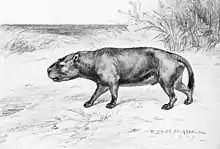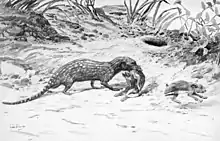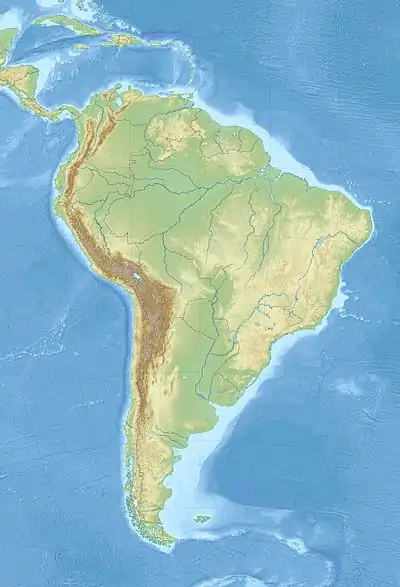| Río Frías Formation | |
|---|---|
| Stratigraphic range: Middle Miocene (Friasian) ~ | |
| Type | Geological formation |
| Overlies | Ñirehuao Formation |
| Lithology | |
| Primary | Tuff, tuffite, siltstone, unconsolidated sand, conglomerate |
| Location | |
| Coordinates | 44°36′S 71°12′W / 44.6°S 71.2°W |
| Approximate paleocoordinates | 45°12′S 66°18′W / 45.2°S 66.3°W |
| Region | Aysén Region |
| Country | |
| Extent | Aysén Basin |
| Type section | |
| Named for | Río Frías |
| Named by | Santiago Roth |
| Year defined | 1898 |
 Río Frías Formation (Chile) | |
Río Frías Formation (Spanish: Formación Río Frías) is a Middle Miocene geologic formation made up sedimentary rock located in Aysén Region, western Patagonia. The formation crops out along the upper couse of Cisnes River (Spanish: Río Cisnes).[1] Marsupial fossils have been found in the formation.[2] The Friasian period in the South American Land Mammal Ages is named after the formation.[3]
Description
Río Frías Formation was discovered by Santiago Roth in the summer of 1897–98. Roth was a Swiss immigrant who had been sent to survey the area by Francisco Moreno. Moreno was director of La Plata Museum and was involved in the Cordillera of the Andes Boundary Case between Chile and Argentina, thus there was both a political and scientific motivation behind the exploration of Patagonia. Santiago Roth called the upper course of Río Cisnes for Río Frías being unaware that it was the same river. Further he thought this unexplored area to be in Argentina and not in Chile. This led the formation to acquire its name.[1] Roth sent fossils he collected from the formation to Florentino Ameghino who was active at La Plata. It was with this fossils Ameghino established the Friasian period.[1] Later research on 40Ar/39Ar data revealed the base of the formation dating to 16.5 Ma, which means a slight overlap with the Santacrucian land mammal age (ending at 16.3 Ma).[4] The formation was deposited in a fluvial environment, characterized by an intermontane valley flanked by Cretaceous basement rocks.[5]
Fossil content
The following fossils have been found in the formation:
| Group | Fossils | Image | Notes |
|---|---|---|---|
| Mammals | Astrapotherium hesperinum |  | |
| Prothylacinus patagonicus |  | ||
| Adinotherium sp. |  | ||
| Nesodon sp. |  | ||
| Protypotherium sp. |  | ||
| Borhyaena tuberata |  | ||
| Theosodon sp. | |||
| Cladosictis patagonica |  | ||
| Pachyrukhos sp. | |||
| Homalodotherium sp. |  | ||
| Abderites meridionalis, Alloiomys friasensis, Megathericulus friasensis, Microbiotherium tehuelchum, Parabderites bicrispatus, Palaeothentes intermedius, P. lemoinei, P. minutus, Pichipilus halleuxi, Pitheculites rothi, Prototrigodon rothi, Sipalocyon gracilis, Neonematherium sp., Phoenixauchenia sp., ?Propalaehoplophorus sp., Prozaedyus sp., Trachytypotherium sp., Platyrrhini indet. | |||
References
- 1 2 3 Marshall & Salinas, 1990
- ↑ Marshall, 1990
- ↑ Paleo Database: Friasian
- ↑ Bostelmann et al., 2012, p.44
- ↑ Bellosi et al., 2014, p.40
- ↑ Río Frías at Fossilworks.org
- ↑ Alto Río Cisnes at Fossilworks.org
Bibliography
- Abello, María Alejandra, and David Rubilar Rogers. 2012. Revisión del género Abderites Ameghino, 1887 (Marsupialia, Paucituberculata). Ameghiniana 49(2). 164–184. Accessed 2019-02-15.
- Bellosi, Eduardo S. et al. 2014. Ambientes asociados a la fauna Friasense (Mioceno Medio) en Alto río Cisnes (Aysén, Chile), 40–41. XIV Reuñión Argentina de Sedimentología. Accessed 2018-09-10.
- Bostelmann, J.E. et al. 2012. The Alto Río Cisnes Fossil Fauna (Río Frías Formation, Early-Middle Miocene, Friasian SALMA): A keystone and paradigmatic vertebrate assemblage of the South American Fossil Record, 44–45. III Simposio Paleontología en Chile. Accessed 2018-09-10.
- Marshall, Larry G. 1990. Fossil Marsupialia from the type Friasian land mammal age (Miocene), Alto Río Cisnes, Aisén, Chile. Revista Geológica de Chile 17. 19–55. Accessed 2017-10-21.
- Marshall, Larry G., and Patricia Salinas. 1990. Stratigraphy of the Río Frías Formation (Miocene) along the Alto Río Cisnes, Aisén, Chile. Revista Geológica de Chile 17. 57–87. Accessed 2017-10-21.
